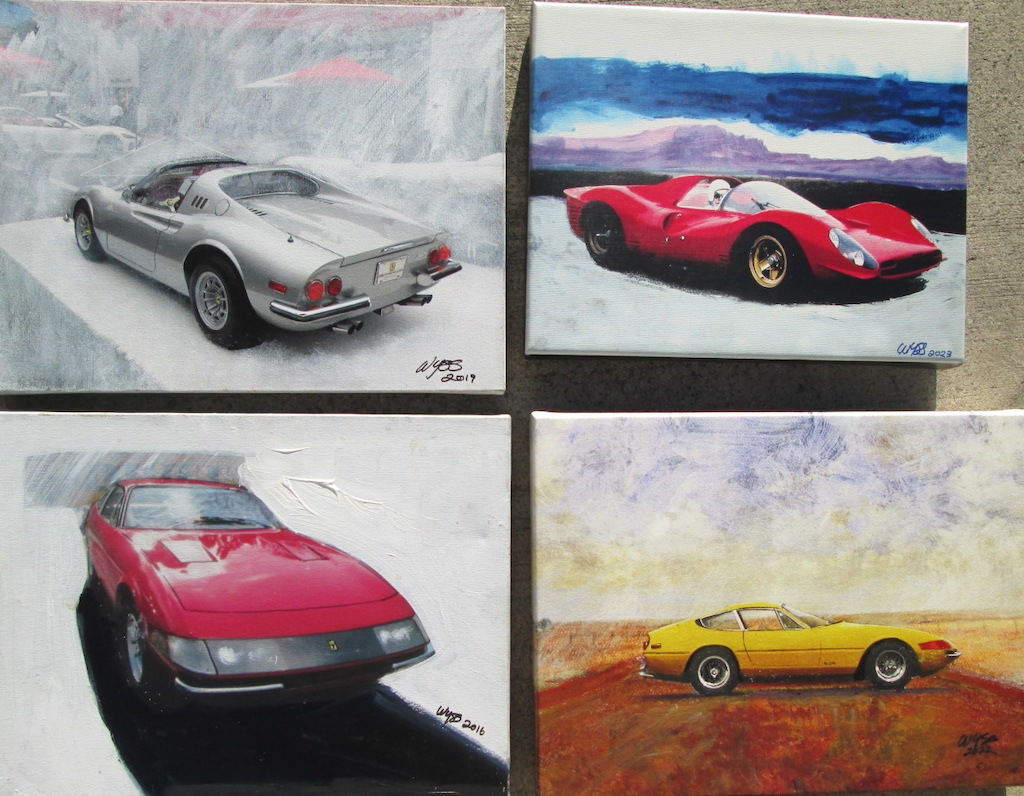Chrysler’s first attempt at an exotic…
by Wallace Wyss –
Chrysler, having turned the corner and making money in the late ’80s, got ambitious to be All Things to All Men and that included building an exotic car, showing the Eye-talians how to do it.
They even bought Lamborghini from some Indonesians whose money was about to run out. And designed their own Lamborghini GT car, one with four, count em four flip up Lambo “scissors” doors. They didn’t have to do any chassis or engineering of the chassis because they built it atop a drivable Jalpa chassis.
It’s hard to remember now what market they were aiming at. They called it “The ultimate mid-engined touring sedan” but was there a market for a four seater Lambo (as there was in the Espada days)? It was originally rolled out at the 1987 Frankfurt Motor Show to announce Chrysler’s takeover of Lamborghini which happened earlier that year on April 23rd.
Chrysler was making it clear that they could and would design Lamborghinis in Detroit. As a sign that Lambo was “captured”, this concept was displayed with Lamborghini’s raging bull held captive within Chrysler’s Pentastar logo.
Earlier, Chrysler had shown a 1986 concept called the Chrysler Navajo attributed to Kevin Verduyn, a Chrysler designer, but that was only a clay model. The Portofino, named after an Italian resort town, was fully functioning. The car was built by Coggiola in Turin, Italy and had to be elongated by 66 cm (26 inches) to create a cabin spacious enough to carry two more passengers.
The Portofino was engineered without B-pillars while all four doors lifted upwards. Leather in three different shades of blue were part of the interior. The driver could adjust the steering wheel, switchgear, and the instrument pod to find the ideal position.
The 3.5-liter V8 engine was rated at 255 horsepower (187 kilowatts) with 229 pound-feet (310 newton meters) of torque. Top speed was quoted as 149 mph (240 kph).
Only one was built and, after a crash in 1991 reportedly $300,000 was spent at Metalcrafters in Costa Mesa, California to restore it. The Portofino is part of a display at Chrysler’s headquarters in Auburn Hills, Michigan.
The design never saw production but it was ground breaking in that it influenced the Chrysler LH body vehicles and their “cab-forward” design standard.
One website spread the opinion that Lamborghini did not like the car, describing it as a “big potato,” but I think the concept is worth reviving as an electric car where you don’t have to worry about where you put the engine. Maybe Lamborghini doesn’t belong to Chrysler anymore but they bought and paid for the design so it’s theirs to play with forevermore.
But oh, one thing, they’ll have to change that badge…
Let us know what you think in the Comments.
THE AUTHOR: Wallace Wyss was invited by the Art Center College of Design to lecture on design history on three different occasions.










This does not look like any Lamborghini that I have seen, or expect to see. The Chrysler badge is appropriate for this style.
This is PROOF that only Italians should design….period.
But especially design cars!
[biting my tongue!!!!!……]
The Portofino was an influential design when it came out and was before they took up their current stealth fighter design direction. As I understand it Kevin. Verduyn was also responsible for the Portofino design. It would have been the best four door exotic car ever. Because Chrysler decided to utilize the design theme on the LH cars it does tend to taint the design today.. I still like it very much.
It reminds me of the Chrysler intrepid.
Great observation, Look it up,the Intrepid and Stratus design was inspired from the Portofino.Basically the Intrepid and the Stratus came from this car.
I was a sculptor at Chrysler Pacifica from 1984 to 2008, when the studio closed… the Portofino and Intrepid was an interesting time to be working for Chrysler Pacifica. Kevin Verduyn was the top designer that really shook up the studio with his innovative designs. The public only sees a tiny fraction of the models produced from Pacifica in Carlsbad, Ca. Now, it’s all just history. Kevin Verduyn has since died of cancer. He could be tough to work for, but I’m a better sculptor because of him…